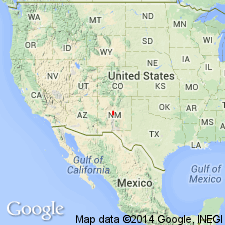
- Usage in publication:
-
- Pine Shadow Member*
- Modifications:
-
- Named
- Dominant lithology:
-
- Conglomerate
- Siltstone
- Shale
- Limestone
- AAPG geologic province:
-
- Estancia basin
- San Juan basin
Summary:
Named the middle member of Wild Cow Formation (new) of Madera Group for Pine Shadow spring near head of Priest Canyon in SW1/4 sec 16, T4N, R5E in Manzano Mountains, San Juan and Estancia basins, NM. Type section designated as on west side, Priest Canyon, sec 7, T3N, R5E, Valencia Co. The Los Moyos section, central Manzanos, Torrance Co, and Sol se Mete, sec 28, T9N, R5E, Bernalillo Co, northern Manzanos, designated as reference sections. Has a basal arkosic conglomerate usually 50 to 90 ft thick that is a steep slope-former that weathers reddish-brown and has cobble-sized, rounded to subround fragments of metamorphic rocks in a poorly sorted, arkosic matrix. Contains fossil wood and fusulinids. Bedding planes commonly ripple marked. Middle part is a thin-bedded, yellow to gray siltstone with minor amounts of shale. Upper part has two ledge- to cliff-forming, olive-gray, locally cherty limestone beds separated by sandstone, shale or siltstone. Is 200 +/-ft thick at type; 150 ft thick at its Sol se Mete reference section; nearly 250 ft at its Los Moyos reference section. Overlies Sol se Mete Member (new); underlies La Casa Member (new), both of Wild Cow Formation. Is of early Virgilian, Late Pennsylvanian age.
Source: GNU records (USGS DDS-6; Denver GNULEX).
For more information, please contact Nancy Stamm, Geologic Names Committee Secretary.
Asterisk (*) indicates published by U.S. Geological Survey authors.
"No current usage" (†) implies that a name has been abandoned or has fallen into disuse. Former usage and, if known, replacement name given in parentheses ( ).
Slash (/) indicates name conflicts with nomenclatural guidelines (CSN, 1933; ACSN, 1961, 1970; NACSN, 1983, 2005, 2021). May be explained within brackets ([ ]).

